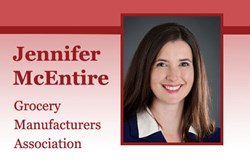Overcoming The Obstacles Of Building A FSMA-Ready Supply Chain Program

By Sam Lewis

The FDA’s final rules for Preventive Controls and Foreign Supplier Verification Program, which were released on September 17 and November 27, 2015, respectively, create new requirements aimed at ensuring the safety of foods, including ingredients and raw materials, through the supply chain. Whether a company is an importer or a manufacturer, if it relies on a supplier to control hazards, it likely will need to develop a supply chain program that includes a process to approve suppliers and to identify verification activities of those suppliers based on risk. Here, Jennifer McEntire, Vice President of Science Operations at the Grocery Manufacturers Association (GMA), answers my questions about creating supply chain control programs.
Food Online: How does a food manufacturer establish a risk-based supply chain program?
 McEntire: While many food manufacturers have had supplier management programs as a part of running their business, establishing a risk-based supply chain program, especially if it’s a required part of a facility’s food safety plan, could be challenging. The final Preventive Controls for Human Food rule specifies the process required for a supply chain program. This includes the criteria that should be considered when determining if a supplier is approved or not, and, once approved, the types of verification activities that could be used to ensure acceptable supplier performance. Although the FDA describes the approval criteria, the rule doesn’t specify how to assign a level of risk to a supplier or a product and doesn’t dictate which verification tools should be used in which situations (with the exception of stating that if an ingredient is associated with a hazard that can cause serious adverse health consequences or death, an annual on-site audit of the supplying facility is the default verification tool in the absence of justification of an alternate approach). Until there is additional guidance from the FDA, establishing a risk-based supply chain program requires the judgment of the facility, and there may be substantial variation in how different facilities develop such a program.
McEntire: While many food manufacturers have had supplier management programs as a part of running their business, establishing a risk-based supply chain program, especially if it’s a required part of a facility’s food safety plan, could be challenging. The final Preventive Controls for Human Food rule specifies the process required for a supply chain program. This includes the criteria that should be considered when determining if a supplier is approved or not, and, once approved, the types of verification activities that could be used to ensure acceptable supplier performance. Although the FDA describes the approval criteria, the rule doesn’t specify how to assign a level of risk to a supplier or a product and doesn’t dictate which verification tools should be used in which situations (with the exception of stating that if an ingredient is associated with a hazard that can cause serious adverse health consequences or death, an annual on-site audit of the supplying facility is the default verification tool in the absence of justification of an alternate approach). Until there is additional guidance from the FDA, establishing a risk-based supply chain program requires the judgment of the facility, and there may be substantial variation in how different facilities develop such a program.
Food Online: Who will struggle the most with the supply chain program, what are its biggest challenges, and how can they be overcome?
McEntire: With respect to the requirements in the final Preventive Controls Rules, I’ve heard many different types of questions from members of GMA as they seek to understand and implement this program. Smaller companies tend to feel they don’t have the purchasing power to get distributors and brokers to disclose to them the true supplier of an ingredient (as defined by the FDA, the supplier is the manufacturer, farm, etc.; brokers and distributors are not considered suppliers). Retailers who are subject to the Foreign Supplier Verification Program (FSVP) wonder how they can evaluate risk of so many different suppliers and products. Products or producing locations that are seasonal also present challenges.
In terms of how these challenges can be overcome, some will be very challenging! I expect there will be some bumps in the road until the community of regulators and industry reach a mutual understanding about how current supply chains work and how they can be best managed. GMA developed a 1-day training course specifically on supplier verification in order to address how some of these situations can be addressed.
Food Online: Who manages the supply chain program once it’s established?
McEntire: That’s entirely up to the company and the particular facility. There are many pieces to the program that involve food safety/QA performing a hazard analysis, procurement, and others approving suppliers, food safety/QA conducting audits and potential testing of approved suppliers products. In addition, there are the day-to-day responsibilities at the receiving dock to make sure ingredients and raw materials that are subject to the program are only received from approved suppliers. The food safety plan should specify how the supply chain program operates and indicate responsibilities and accountability.
Food Online: If a company uses a contracted manufacturer or a co-packer, who does the responsibility of compliance of the supply chain program fall upon?
McEntire: Whenever I talk to food safety professionals about the regulatory requirement, I ask this question, and, inevitably, the responses are split close to 50-50. This is because the FDA does not recognize or make any special mention of a co-manufacturer or co-packer. If your facility is registered with the FDA, you are the producing facility. To the FDA, it doesn’t matter if it’s your brand or not.
However, to the brand owner and the co-manufacturer, we know that it does matter! Customers’ relationships with their co-manufacturers vary widely in terms of who approves suppliers, who order ingredients/raw materials, etc. The contractual relationship can specify these roles, and as facilities develop food safety plans, co-manufacturers and their customers need to make sure they are clear on who will bear responsibility for regulatory requirements, especially when it comes to the supplier program.
Food Online: What would a “compliance checklist” of the supply chain program look like?
McEntire: I’ve worked with many companies to determine the key factors that are important to them in managing their suppliers. Each company has a different way of evaluating its suppliers, although clearly the FDA-specified approval criteria — including regulatory compliance history of the supplier, the supplier’s responsiveness to the customer, etc. — need to be included in any sort of checklist. Once approved, determining appropriate verification activities will depend on many factors, including the culture of the company and the nature of the resources allocated to a supplier program. It’s hard to say that there is a single checklist. That said, even prior to the passage of FSMA, GMA developed a free food supply chain handbook that is available in five languages.
Food Online: What impact will implementing risk-based supply chain programs have on the food manufacturing industry?
McEntire: This, potentially, will significantly change the nature of supply chains, especially the level of visibility through several steps in the chain owing to the definition of supplier, and the need to verify suppliers, if the rule is implemented and enforced as written. Brokers and distributors have an opportunity to perform verification activities on behalf of their customers; this is another significant change. Finally, because of the requirements in the FSVP, some companies are reconsidering their roles as importers.
In terms of food safety, will this type of supply chain program help prevent issues? The FDA is correct that some food safety issues have stemmed from suppliers. In order for the requirements to have the intended effect, companies must take the requirements seriously and give a thoughtful, rigorous evaluation to their suppliers. Experience and resources are needed to get the job done right. Given the uncertainties around how to best address the requirements, we hope that training and industry guidance will provide support and assistance. The next few years are going to be very interesting and I look forward to seeing where the industry lands in developing a manageable program with a measurable impact.
About Jennifer McEntire, Ph.D.
Dr. Jennifer Cleveland McEntire is Vice President of Science Operations at the Grocery Manufacturers Association where she oversees the microbiology, chemistry and packaging laboratories, process authority team, and consumer complaint product forensic analyses.
A food microbiologist by training, Jennifer’s areas of expertise include recall and crisis management, traceability, food defense, and food regulations. Jennifer was previously Vice President and Chief Science Officer at The Acheson Group, where she supported food industry clients through recall and crisis situations.
Prior to joining TAG, Jennifer served as the Senior Staff Scientist and Director at the Institute of Food Technologists (IFT). She also held a two-year appointment with the USDA’s National Institute for Food and Agriculture, and served as a visiting scientist at FDA CFSAN.
Jennifer earned a Doctor of Philosophy from Rutgers University as a USDA National Needs Fellow in food safety and received a Bachelor of Science with Distinction, magna cum laude, in food science from the University of Delaware. She was the 2010 recipient of the Rutgers University Food Science Alumni Association Communication Award and in 2012 was honored with the University of Delaware College of Agriculture and Natural Resources Distinguished Young Alumni award. She has also received two awards from the FDA CFSAN Center Director related to her work on food defense as well as food safety collaboration training materials.
She has authored more than 20 peer reviewed publications, six book chapters, and numerous white papers. She is on the Board of Phi Tau Sigma (the food science honorary society) and is a member of the Advisory Council of the Global Food Traceability Center.
